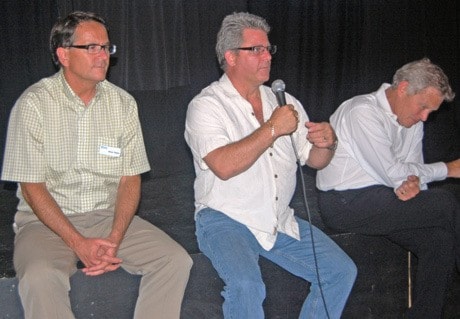Mayor Bruce Banman reassured upset residents of Sumas Mountain that the city will not interfere with their property rights for environmental protection.
Banman and senior municipal staff struck a conciliatory tone as they met with mountain residents at Straiton Community Hall on Tuesday night and listened to three hours of public speaking.
“I have no vested interest in what this becomes,” said Banman, who encouraged residents to provide input to the city that would help guide a new Official Community Plan (OCP) for the area formerly known as Area H before it was absorbed by Abbotsford from the Fraser Valley Regional District in 2008.
Banman said a combination of misinformation and lack of public consultation led to the belief people were going to be losing lands to the city, but that won’t be happening.
A hundred people packed the hall, the entire municipal council among them, to address concerns about the newly completed Sumas Mountain Environmental Management Study (SMEMS), which has identified biodiversity hotspots in the area and classified them into high, moderate, and low/no habitat sensitivity designations.
But resident Trevor Newton expressed skepticism as to how the information was gathered on private property.
“Is it because you know the red-legged frog is located there, or because it’s a place the frog might like to live?” he asked, to a mix of laughter and applause.
The burning issues were whether the environmental study would impact private property rights and how much consultation Abbotsford initially intended to have with residents.
T.M. Sandulak said Abbotsford undertook the study without public consultation and with every intention of pushing through the OCP prior to the backlash.
“What’s happening tonight is damage control,” he said, as heads nodded in the audience.
Banman conceded there have been a number of issues that degraded public trust, such as a letter that was mistakenly sent out to rural uplands residents that they would now need to cut down bushes and clear blockages in city-owned ditches.
“When I found out what was going on I was less than impressed,” he said, adding the process got twisted so bad he’s not surprised residents “don’t believe a damn word we say.”
Residents seemed genuinely appreciative of Banman’s candid remarks, who also spoke about his upbringing on rural land.
When Jason Waddilove asked what pressures were forcing the city to create a development plan for Sumas Mountain, Banman pointed to population growth. Asking for a show of hands, the mayor asked how many landowners in the room believed the mountain would be see more development over the next 50 years. After nearly every hand went up, Banman concluded that was the reason the city needs an “intelligent” plan.
Most people spoke to a need for a balance between conservation and development, the protection of wildlife habitat and the preservation of private property rights.
Jay Teichroeb, the city’s general manager of economic development and planning, said property rights will absolutely be respected, though that didn’t seem to satsify some in the room.
Newton said when he went to the city about putting in a chain link fence on his property they responded with a letter about his “chain link fence development,” generating initial laughs which subsided when he explained the $1,500 city fee for this “development.”
Also at issue is the subject of road maintenance on the mountain, which in some parts is heavily degraded by the hundreds of gravel trucks running up and down the mountain. The city says it’s a provincial issue until July 2013, while some people say they’ve been told by the province the city needs to fix them.
And although the issue of gravel mines itself was discussed at length by many, city officials reminded people that it’s a provincial jurisdiction that is unrelated to the SMEMS study.
The study calls for a new residential neighbourhoods that are environmentally and economically sustainable. It envisions the implementation of interconnecting greenspaces of conservation lands, parks, trails and protected areas. The current OCP was developed in 2003 by the FVRD.
The next community meeting happens Sept. 11 at Straiton Hall.
